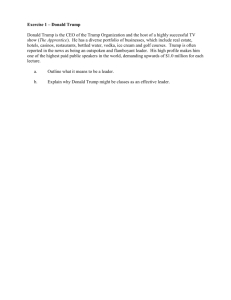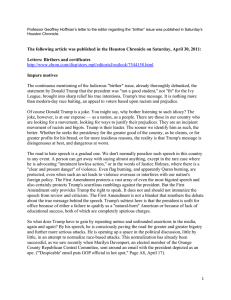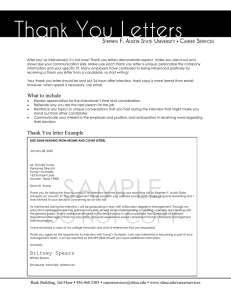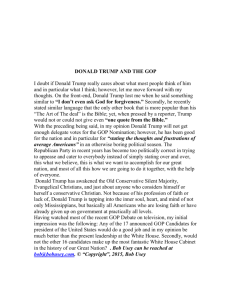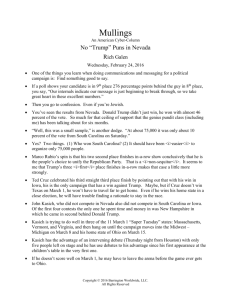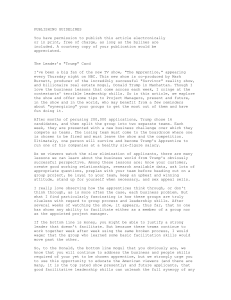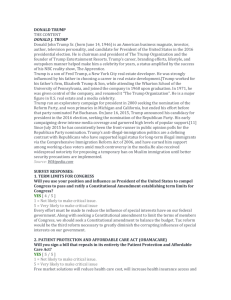The Mathematics Behind Euchre
advertisement
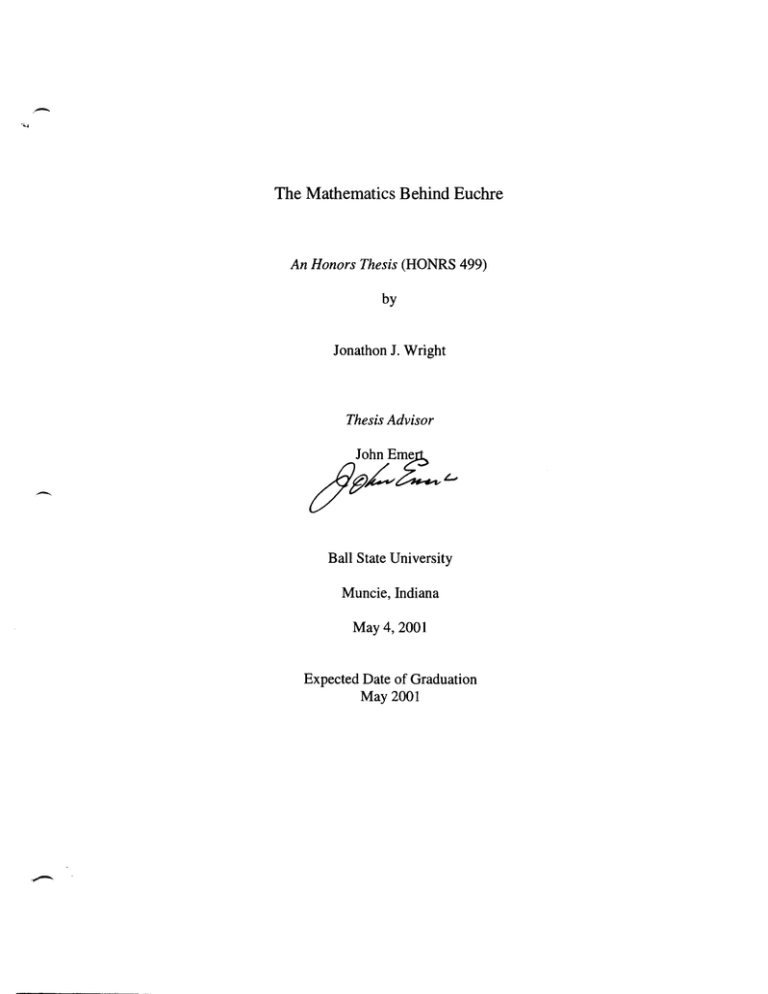
The Mathematics Behind Euchre
An Honors Thesis (HONRS 499)
by
Jonathon J. Wright
Thesis Advisor
.-
Ball State University
Muncie, Indiana
May 4, 2001
Expected Date of Graduation
May 2001
Acknowledgements
The author would like to thank several people who have assisted in the
completion of this honors thesis. Special thanks go out to Professor John Emert
for his support and guidance throughout the completion of this project and also
his proof reading efforts. Gratitude also goes to Dr. Kerry Jones for his direction
concerning the Monte Carlo system used to model the playing out of the hands of
Euchre. Without your help and assistance this thesis would never have become a
reality.
,Abstract
This thesis delves into the complex card game of euchre in an effort to
display the mathematics behind the game. There are two major elements of
euchre where the mathematics will be explored. The first is the shuffling of the
24 cards in the euchre deck. This will entail using normal distribution along with
the random number generator and matrix multiplication. The final aspect will be
to model how a given hand will be played out assuming the players understand
how to play. This will be done using a Monte Carlo system, as there are too many
possible ways to play to feasibly model them all. Therefore, the Monte Carlo
system will allow the modeling using the random function and one hundred
thousand iterations, without contemplating theoretically every possible
combination of how the hands could be played.
Table of Contents
I.
The History of Euchre .......................................................... 1.
II.
The Rules of Euchre ............................................................ 2.
m.
Modeling the Shuffling of Euchre ............................................ 5.
IV.
Monte Carlo System ............................................................ 8.
V.
Monte Carlo System Graphs ................................................. 13.
VI.
Conclusions .................................................................... 16.
Appendix ................................................................................ 17.
References .............................................................................. 32.
-
--
The History of Euchre
Numerous card historians have determined that euchre is a direct
descendant of the Spanish game Triomphe. Nevertheless, euchre also shares
similarities to another European card game of German origin called Juckerspiel.
An early version of euchre was played extensively in France during the 1700s
under the name Ruff.
During the reign of Napoleon in Europe, euchre was modernized and
brought to America in the French controlled New Orleans. From Louisiana the
game traveled up the path of the Mississippi River into the northern states where
-
it gained considerable popularity. Nearly 100 years ago, euchre was the number
one card game in the United States. Even so, a few decades later, the game's
popularity succumbed to bridge, spades, and hearts. However, euchre is still
adored by many. There is a national organization and there are several web sites
devoted solely to the game. Even though euchre is not the most popular card
game in the United States, it is still tremendously admired in the Midwest states
of Indiana, Ohio, lllinois, Wisconsin, and Michigan.
-
The Rules of Euchre
The rules of euchre include several variations. The most common way to
play utilizes four players as two teams of two and a pack of 24 cards created by
using only nines through Aces of a regular deck of 52. Another variation consists
of using a pack of 32 cards produced by using sevens through Aces of a regular
deck of 52. There are many other variations to the game such as three-handed
euchre, two-handed euchre, railroad euchre, and call ace euchre. However, I will
focus my attention on the most popular version.
-
The highest trump is the jack, called the right bower. The second highest
is the other jack of the same color, called the left bower. For instance, if spades
are trump, the jack of spades is the right bower and the jack of clubs is the left
bower. The rest of trump suit ranks A (third-best), K, Q, 10,9. For non-trump
suits, the rank is A (high), K, Q, J (if not left bower), 10, and 9. Each player is
dealt five cards in-groups of 3-2 or 2-3, and the dealer must adhere to their
original order of dealing. The succeeding card in the pack is flipped face up on
the table and is referred to as the tum-up card.
The tum-up card proposes the trump suit for that deal, but only becomes
trump if one of the players accepts it. Starting with the player on the dealer's left,
each player in tum may pass or accept the suit of the tum-up card. An opponent
of the dealer accepts by saying, "Pick it up." The dealer accepts by saying, "I
-
pick it up." If all four players pass, the tum-up card is turned face down. Then
2
-
each player in tum has a second chance to pass or name a trump suit. The suit
named must be different than the suit of the tum-up card. This process does not
have to make it all the way around the table to each player; it stops as soon as
someone makes trump.
Whoever chooses the trump suit by either accepting the tum-up card or
declaring the suit in the second round, becomes the caller. The caller has the right
to say, "I play alone," becoming a lone caller, in which case his partner discards
his hand and stays out of play.
If the tum-up card is accepted, the dealer has the right to use it as part of
his hand, exchanging if for a card in his hand. The player to the left of the dealer
makes the opening lead. If there is a lone caller, the player to the lone caller's left
has the first lead. The hands are played out in five tricks. A player must follow
suit if able; if unable to follow suit, he may play another card. A trick is won by
the highest trump played to it, or by the highest card of the suit led if no trump is
present. The winner of the trick leads the next trick.
Only the team winning three or more tricks scores. Winning all five tricks
is called a march. When the calling team fails to win the majority, they have been
euchred. The calling side scores one point for three or four tricks or two points
for a march. A caller playing alone scores one point for three or four tricks or
four points for a march. Opponents of the caller score two points for a euchre.
Usually, each team keeps track of their points won by using two low cards, such
as a six and a four, by exposing a dot for each point won. The team to reach a
total of ten points first wins the game.
3
The same dealer re-deals if a card is exposed or if the pack is found to be
incorrect. If a player leads out of tum and the trick is gathered, it stands as
regular. Otherwise the bad lead becomes an exposed card and other cards played
to it may be retracted without penalty. At the next proper tum of the offending
side to lead, the opponent to his right may name the suit to be led. This penalty
does not apply to a lone player, but he may be required to retract a lead out of
tum. If a player (not playing alone) exposes a card from his hand except in proper
play, he must leave it face up on the table and must play it at his first legal chance.
If a player looks at a quitted trick or gives illegal information to his
partner, then the next time the offending team has the lead, the opponent to the
right of the leader may name the suit to be lead. Furthermore, failure to follow
suit when able is a renege. A player may correct his renege before a trick is
gathered. Otherwise it stands as an established renege, meaning the opponents of
the offender may score two points .
-
.
4
Modeling the Shuming of Euchre
I have set out to model the shuffling of the most common version of
euchre where there are 24 cards using visual C++. The first step in this process is
to create a random deck of cards. To accomplish such a task I set up a onedimensional array (vector) with 24 positions containing values incremented by
one all the way to 24. Each one of these 24 numbers represents one of the 24
cards used in the game. Whereas one is the ace of hearts, two is the king of
hearts, and so on for all suits. Once this vector was set up, I utilized a for-loop
from one to 24 which randomly chose the first card and moved it to the first
.-
position of another array and continued randomly choosing cards without repeat
until all 24 cards were randomly located in the new array. From here I had a
random deck of cards to begin the game with, but I needed to shuffle them.
The next step in modeling card shuffling is to determine where the deck of
cards will be split. Usually the deck is approximately split in half and the cards
are then shuffled. To model this, normal distribution appeared to work very well
using a mean of 12.5 and a variance of 3. Subsequently, this causes the majority
of card splitting to occur between cards 10 through 15 as a split any worse would
most likely be noticed by the shuffler.
Once the deck is split, the shuffler has a stack of cards in their right and
-
left hand. When shuffling, I assumed that the cards weren't evenly shuffled. I
assumed that at most, two cards from the left or the right stack were piled
5
together. I then used the random number generator to decide whether one or two
cards from either the left or right stack would be used. Then I alternated between
the right and left deck until the cards were all piled upon one another.
To actually model this, I commenced with a 24 by 24 identity matrix.
When this matrix is multiplied by the randomly chosen deck, the result is the
randomly chosen deck. The reason for this is that the one in each row of the
identity matrix when multiplied by the randomly chosen deck, determines the
reSUlting position of the randomly chosen deck. The identity matrix does not
change the original position. Therefore, I needed to manipulate the arrangement
of the identity matrix rows to produce a 24 by 24 shuffle matrix.
The split row of the identity matrix was moved to the bottom of the shuffle
matrix occasionally with the preceding identity row. Then the bottom row of the
identity matrix followed to the bottom (above previously defined rows) of the
shuffle matrix also occasionally with the preceding identity matrix row. This
continued until one stack ran out first and the remaining rows of the identity
matrix were placed in the top rows of the shuffle matrix. To shuffle the cards, the
random deck array was multiplied by the 24 by 24 shuffle resulting in a newly
shuffled deck.
The following is a diagram of the shuffling process:
Initialized Deck of Cards
[1 2 3 4 5 6 7 8 9 10 11 12 13 14 15 16 17 18 19 20 21 22 23 24]
Randomly Chosen Deck
[9 2 18 5 6 22 8 10 3 11 24 13 1 14 15 23 16 17 19 12 20 7 21 4]
-..
6
-
24 by 24 Identity Matrix
[1 00000000000000000000000]
[0 1 0 0 0 0 0 0 0 0 0 0 0 0 0 0 0 0 0 0 0 0 0 0]
[0 0 1 0 0 0 0 0 0 0 0 0 0 0 0 0 0 0 0 0 0 0 0 0]
~OOIOOOOOOOOOOOOOOOOOOO~
[0 0 0 0 I 0 0 0 0 0 0 0 0 0 0 0 0 0 0 0 0 0 0 0]
[0 0 0 0 0 I 0 0 0 0 0 0 0 0 0 0 0 0 0 0 0 0 0 0]
~0000010000000000000000~
~OOOOOOIOOOOOOOOOOOOOOO~
~0000000100000000000000~
[0
[0
[0
[0
00
00
00
00
00
00
00
00
00
00
00
00
00
00
00
00
I 000
0 I00
00 I 0
000 I
00
00
00
00
00
00
00
00
0
0
0
0
0
0
0
0
0
0
0
0
00
00
00
00
0
0
0
0
0]
0]
0]
0]
~0000000OOOOOI000000000~
~OOOOOOOOOOOOOIOOOOOOOO~
[0 0 0 0 0 0 0 0 0 0 0 0 0 0 0 1 0 0 0 0 0 0 0 0]
[0 0 0 0 0 0 0 0 0 0 0 0 0 0 0 0 I 0 0 0 0 0 0 0]
~OOOOOOOOOOOOOOOOIOOOOO~
~OOOOOOOOOOOOOOOOOIOOOO~
,-
[0 0 0 0 0 0 0 0 0 0 0 0 0 0 0 0 0 0 0 I 0 0 0 0]
[0 0 0 0 0 0 0 0 0 0 0 0 0 0 0 0 0 0 0 0 I 0 0 0]
[0 0 0 0 0 0 0 0 0 0 0 0 0 0 0 0 0 0 0 0 0 I 0 0]
[0 0 0 0 0 0 0 0 0 0 0 0 0 0 0 0 0 0 0 0 0 0 I 0]
[00000000000000000000000 I]
24 by 24 Shuffk Matrix
*
[0 0 0 0 0 0 0 0 0 0 0 0 1 0 0 0 0 0 0 0 0 0 0 0]
~OOOOOOOOOOOOIOOOOOOOOO~
~OOOOOOOOOOOOOIOOOOOOOO~
[IOOOOOOOOOOOOOOOOOOOOOO~
[0 I 0 0 0 0 0 0 0 0 0 0 0 0 0 0 0 0 0 0 0 0 0 0]
~OOOOOOOOOOOOOOIOOOOOOO~
~0100000000000000000000~
[0
[0
[0
[0
[0
0 0 10 0 0 0 0
00000000
00000000
0 0 0 10 0 0 0
0 0 0 0 10 0 0
0
0
0
0
0
0
0
0
0
0
00
00
00
00
00
00
00
00
00
00
000
0 10
00 I
000
000
0
0
0
0
0
0 0 0 0 0]
0 0 0 0 0]
0 0 0 0 0]
0 0 0 0 0]
0 0 0 0 0]
~0000000000000000010000~
[0
[0
[0
[0
[0
[0
00
00
00
00
00
00
00
00
00
00
00
00
0 100 0 0 0 0 0 0 0 0
0 0 10 0 0 0 0 0 0 0 0
000000000000
000000000000
000 100 0 00 00 0
000000000000
0
0
0
0
0
0
0
0
0
0
0
0
0 0 0 0 0]
0 0 0 0 0]
1 0 0 0 0]
0 1 0 0 0]
0 0 0 0 0]
0 0 1 0 0]
~0000000000000000000001~
,-
[0 0 0 0 0 0 0 0 0 1 0 0 0 0 0 0 0 0 0 0 0 0 0 0]
[000000000000000000000001]
[0 0 0 0 0 0 0 0 0 0 I 0 0 0 0 0 0 0 0 0 0 0 0 0]
(0 0 0 0 0 0 0 0 0 0 0 1 0 0 0 0 0 0 0 0 0 0 0 0]
Randomly
Chosen Deck
[9]
[2]
[18]
[5]
[6]
[22]
['8 ]
[10]
[3]
[11]
[24]
[13]
[ 1]
[14]
[15]
[23]
[16]
[17]
[19]
[12]
[20]
[7]
(21 ]
(4 ]
Shuffled Deck
[5]
[6]
[8]
[10]
[24]
[13]
[14]
[15]
[17]
[20]
[21]
[4 ]
[9]
[2]
[18]
[22]
[63]
[11 ]
[ 1]
[23]
[16]
[19]
(12]
[7]
Monte Carlo System
Quite often in the field of mathematics it is extremely difficult to exactly
model situations. For instance, when trying to find the area of an irregular region,
it is tricky to find the actual equation to model the border. An individual could
spend a tremendous amount of time attempting to find such an equation.
However, if the irregular region were circumcised in a square of known area
where one hundred random shots were fired, the proportion of shots hitting the
region would give a good approximation of the area. In addition, the more shots
fired the more exact the area approximation would be.
-
However, this method wouldn't be very useful for modeling the area of a
square. The exact area of the square could easily be found by measuring the
length of one side and squaring it. The method of random shots isn't exact and
would take much longer to model the area.
The example of using many random shots to model situations that are
extremely complex is the basis of Monte Carlo Systems. These systems utilize
random events to model situations and these events are run numerous times. This
is a reliable method as many random events develop of good picture of what is
actuall y occurring.
The final endeavor of this honors thesis entails determining how a given
deal of euchre will be played out. Due to the multitude of possible ways the deal
-.
could be played, a Monte Carlo System was used. Such systems use the random
8
number generator, coded strategy, and numerous iterations to model what the
probability of either team will be to win the hand with their given cards.
To set up this Monte Carlo System I utilized visual basic. The initial step
included setting up each of the four players with five cards. Player one and three
are on a team versus players two and four. For the system, player one received
the nine and Ace of Clubs, the nine and Ace of Spades, and the nine of hearts.
Player two was given the ten and jack of clubs, nine and ten of diamonds, and the
ten of spades. Player three was furnished with the ten and jack of hearts, jack of
spades, jack of diamonds, and the queen of clubs. In addition, player four was
bequeathed the queen of hearts, queen and king of spades, queen of diamonds,
and king of clubs. However, the Monte Carlo System will function properly for
-.
any valid euchre deal.
Next, the Dealer needed to be determined. The dealer for every hand is
chosen randomly as they could be any of the four players and many iterations will
allow on average all four players to deal equally. With the dealer selected, the
leader is subsequently chosen, as they are the person to the left of the dealer.
Therefore if player four dealt, then player one would be the leader.
The leader has many options available at their disposal. First of all they
may either lead trump or not. This was set to be random as long as they had
trump in their hands. The reasoning behind allowing this to be random is that
they are both equally likely strategies depending on the person's playing style and
should be modeled so as to reflect this. If the leader plays trump then they will
play their highest trump in hopes of winning the trick while removing the other
9
players of their trump. Playing their lowest trump wasn't modeled, as this would
usually cause their trump to be beaten by another resulting in the loss of one of
their highest valued cards.
If the leader decides to not play trump, then they have the choice of either
playing their highest non-trump card or their lowest. They would play their
highest in hopes that others will have to follow suit allowing them to win the
trick. By playing the lowest card they would in effect be relying on their partner
to win the trick and most likely be throwing away their card. This choice to either
playa high or low non-trump card was also allowed to be random as both options
are exercised frequently.
This brings us to the first follower. This person must follow suit if
possible. They have the option of either playing their lowest follow suit card if
they can't beat the leader or their highest if it is better than the leader. If they can't
follow suit then they have the option of playing trump as long as the lead card
isn't trump. They will want to play their lowest trump card so as to maximize the
value of their highest if they do have better. In addition, they wouldn't play
trump if they had the right bower, as this is an automatic trick and usually used to
take out high trump cards such as the left bower. If their hand doesn't contain
trump, then the follower would want to play the lowest card in their hand.
The subsequent follower plays by the same principles as the first follower,
but they must also take into account what the follower and leader have already
played. For instance, if they have to follow suit and nothing in their hand beats
what has been played then they will play their lowest follow-suit card. In
10
-
addition, they will not trump in if the follower has already done so and follower
two can't beat follower one with their trump. If so, they will play their lowest
card. Follower three plays just like the other followers except that they must
taken into account what the leader, follower one, and follower two have played.
This is the backbone of the logic behind the leader and follower
relationship. The random number generator is used to model the leader as their
decisions can vary greatly. However, the follower really doesn't have much
random choice as to what they will play. These followers play by strategy.
To better model all the possible outcomes, this scenario for the given hand
was run for all four values of trump. The number of tricks won by each team for
all four values of trump using the given cards was recorded. Then such a model
was ran for a multitude of iterations.
After 10,000 iterations, player one and three which I will call team one,
won 79 percent of all the hands whereas player one and two called team two, took
only 21 percent of the hands. Looking a little deeper, when hearts were trump,
team one won every single hand. This makes sense as player three had the right
and left bower along with the ten of hearts while his partner had the nine of
hearts. In addition team two combined with only the queen of hearts. In addition,
when diamonds were trump team one dominated with 97 percent as player three
had both bowers.
When spades were trump, team one won 70 percent while team two
picked up only 30. This appears to be correct as team one had the 9 and Ace of
-
spades, and the right bower. While team two had the 10, queen, and king of
11
spades. Team one had overall better cards, but depending on how they were
played, team two still had a chance.
Nevertheless, with clubs trump the wins were almost evenly split with
team one taking a little over 50 percent of the hands. The reason behind this is
that both teams had nearly even trump hands. Teams one possessed the 9, queen,
and ace of clubs, and the left bower. Team two combined for the 10, and king of
clubs, and the right bower.
Iterations of 100, 1000, 10000, and 100000 were run to compare the
results. Samples with a smaller number of iterations had a greater variance. This
is due to the law of large numbers. The more times you run the system the less
the variance and the closer the answer is to the exact value. Nonetheless, all four
sets of iterations were extremely close with the maximum difference of a little
more than one percent. Therefore, a huge amount of iterations isn't necessary, as
the system is very random and not exceptionally biased.
12
)
)
Number of Winning Hands 1000 Iterations
3500
3000
2500
en
"C
C
CIS
::I:
g' 2000
·cc
II Players 1 and 3
-3:
II Players 2 and 4
~ 1500
CI)
.g
E
:::J
Z
1000
500
o
Hearts
Spades
Diamonds
Clubs
Trump
Total Wins
Percentage
Wins
')
)
•
Number of Winner Hands With 10000 Iterations
12000
10000
II)
8000
"C
C
ca
J:
m
c
'2
c
i...
1111 Players 1 and 3
6000
• Players 2 and 4
G)
.Q
E
::::J
Z
4000
2000
o
Hearts
Spades
Diamonds
Trump
Clubs
)
)
Number of Winning Hands 100,000 Iterations
350000
300000
250000
til
"cac
I
~
200000
'2
III Players 1 and 3
c
~
-
• Players 2 and 4
~ 150000
G)
Jl
E
:J
Z
100000
50000
o
Hearts
Spades
Diamonds
Clubs
Trump
Total Wins
.Conclusions
At first glance, the underlying mathematics behind the game of euchre
didn't seem extremely complicated. My first endeavor of modeling card shuffling
was a little complicated, but overall it was rather easy. I assumed modeling how a
set of cards would be played out would have a similar difficulty level. However,
this was not the case. I began writing the Monte Carlo System in visual basic and
expected it to be just a few pages. To my surprise the code ended up being more
than ten pages. The system worked as I expected, but I never imagined the logic
behind such a Monte Carlo System would be so long and complicated.
However, one major surprise with the Monte Carlo System was the
accuracy of very few iterations. The percentage of wins using 100 and 100,000
iterations were almost identical. The reasoning behind this is due to the fact that
the system is very random and not significantly biased, therefore eliminating the
need for a large number of iterations.
16
Module1 - 1
'Appendix A
Sub MonteCarlo()
'(Player Number, Cards Num, Value = (1-6), Suit = (H=l, S=2, D=3, C=4)
Dim Cards (4, 6, 2), TurnCard(l, 1, 2), HandWinner(100000, 4), TrickWinner(5, 4) 'five tricks anc
four possible trumps
Dim NumHeartTrumpWin(2), NumSpadeTrumpWin(2), NumDiamondTrumpWin(2), NumClubTrumpWin(2)
Iteration2 = 100000
For Iteration = 1 To Iteration2
Randomize
For Trump
=
1 To 4
'Set up Players Hands
'Player 1
1
Cards (1, 1, 1)
Cards (1, 1, 2)
4 '4
-
Cards(l, 2, 1)
Cards (1, 2, 2)
1
2 '2
Cards (1, 3, 1)
Cards(l, 3, 2)
6
2 '2
Cards (1, 4, 1)
Cards (1, 4, 2)
6
4 '4
Cards (1, 5, 1)
Cards (1, 5, 2)
1
1
'Player 2
Cards (2, 1, 1)
Cards (2, 1, 2)
2
4 '4
Cards (2, 2, 1)
Cards (2, 2, 2)
2
2 '2
Cards (2, 3, 1)
Cards (2, 3, 2)
3 '3
4 '4
Cards (2, 4, 1)
Cards (2, 4, 2)
1 '1
3 '3
Cards (2, 5, 1)
Cards (2, 5, 2)
2
3
'Player 3
Cards(3, 1, 1)
Cards (3, 1, 2)
3
2
Cards (3, 2, 1)
Cards (3, 2, 2)
4
4
Cards (3, 3, 1)
Cards (3, 3, 2)
2
1
Cards (3, 4, 1)
Cards (3, 4, 2)
3
1
Cards (3, 5, 1)
Cards (3, 5, 2)
3
3
'Player 4
Cards(4, 1, 1)
Cards (4, 1, 2)
4
2 '2
Modulel - 2
-
Cards(4, 2, 1)
Cards(4, 2, 2 )
5
2 '2
Cards(4, 3, 1)
Cards(4, 3, 2)
5 '5
4 '4
Cards (4, 4, 1)
Cards (4, 4, 2)
4 '4
3 '3
Cards(4, 5, 1)
Cards(4, 5, 2)
4
1
'Changes Values of Trump Bowers from 3 to 8 and 7 for right and left respectively
For i
1 To 4
For j
=
1 To 5
Select Case Trump
Case 1
j , 2)
Cards(i, j, 1)
End I f
= 1
= 8
j, 2)
Cards(i, j, 1)
Cards(i, j, 2)
End I f
=
And Cards(i, j, 1)
3 Then
j, 1)
3 Then
And Cards(i, j, 1)
3 Then
j, 2 ) = 4 And Cards(i, j, 1)
C:uds (i, j, 1)
7
Cards(i, j , 2) = 2
End I f
3 Then
I f Cards(i,
I f Cards(i,
3 And Cards(i,
7
1
=
Case 2
-
j, 2)
Cards(i, j, 1)
End I f
I f Cards(i,
= 2
= 8
I f :ards(i,
Case 3
I f Cards(i,
j,
2)
Cards(i, j, 1)
End I f
I f Cards(i,
j,
2)
Cards(i, j, 1)
Cards(i, j, 2)
End I f
= 3
= 8
=
=
And Cards(i, j, 1)
3 Then
1 And Cards(i, j, 1)
3 Then
7
3
Case <I
I f Cards(i, j, 2) = 4 And Cards(i,
Cclrds (i, j, 1) = 8
End I f
I f Cards(i,
j,
2)
Cards(i, j, 1 )
Cards(i, j, 2)
End I f
End Select
Next j
Next i
".
= 2
=
7
4
1)
3 Then
And Cards(i, j, 1)
3 Then
j,
Module1
-
-
3
Select Case Trump
Case 1
"H"
Suit
Case 2
tis ..
Suit
Case 3
"D n
Suit
Case 4
"C"
Suit
End Select
'Randomly Chooses Dealer and subsequently chooses Leader
Dealer = Int(4 * Rnd) + 1
If Dealer = 4 Then
Leader
1
Else
Dealer + 1
Leader
End If
For Trick
=5
To 1 Step -1
'Leader plays trump or not
'See if Leader has trump
NumTrump = 0
For i = 1 To Trick
If Cards (Leader, i, 2) = Trump Then
NumTrump = NumTrump + 1
End If
Next i
'if TrumpJrNot = 1 lead trump if have or have all trump, else don't lead trump
TrumpOrNot = Int(2 * Rnd) + 1
If (NumTrwnp > 0) And (TrumpOrNot
'Plays Leaders Highest Trump
TempLeaderValue = 0
TempLeaderSuit = 0
1)
Or NumTrump
Trick Then
If NwnTrump > 0 Then
For i = 1 To Trick
If Cards (Leader, i, 2) = Trump Then
If Cards (Leader, i, 1) > TempLeaderValue Then
TempLeaderValue = Cards (Leader, i, 1)
TempLeaderSuit = Cards (Leader, i, 2)
End If
End If
Next i
End If
Else
'Leader doesn't play trump
Modulel - 4
-
For i = 1 To Trick
If Cards {Leader, i, 2) <> Trump Then
TempLeaderValue = Cards (Leader, i, 1)
TempLeaderSuit = Cards (Leader, i, 2)
Exit For
End If
Next i
HighOrl,ow = Int (2 * Rnd)
+
1
If HighOrLow = 1 Then
'Play lowest card
For i
=
1 To Trick
If Cards (Leader, i, 1) < TempLeaderValue And Cards (Leader, i, 2) <> Trump Then
TempLeaderValue = Cards (Leader, i, 1)
TempLeaderSuit = Cards (Leader, i, 2)
End If
Next i
Else
'Play highest card
For i = 1 To Trick
.-
If Cards (Leader, i, 1) > TempLeaderValue And Cards (Leader, i, 2) <> Trump Then
TempLeaderValue = Cards (Leader, i, 1)
TempLeaderSuit = Cards (Leader, i, 2)
End If
Next i
End If
End If
'Followers
If Leader = 4 Then
Follower
1
Else
Followe.(
Leader + 1
End If
NumFollowSuit = 0
'Find the number of cards the follower has in hand to follow suit
For i = 1 To Trick
If Cards{Follower, i, 2) = TempLeaderSuit Then
NumFo:_lowSui t = NumFollowSui t + 1
End If
Next i
If NumFollowSuit > 0 Then
'Find card in deck that can follow suit
For i = 1 To Trick
If Cards {Follower, i, 2) = TempLeaderSuit Then
TempFollowerValue = Cards {Follower, i, 1)
TempFollowerSuit = Cards (Follower, i, 2)
End If
Modulel - 5
-
Next i
'Find the largest and smallest Follow suit card
TempFollowerBigValue = TempFollowerValue
TempFollowerSmallValue = TempFollowerValue
=
For j
1 To Trick
If Cards (Follower, j, 2) = TempLeaderSuit Then
If Cards (Follower, j, 1) >= TempFollowerBigValue Then
TempFollowerBigVa1ue = Cards (Follower, j, 1)
TempFollowerBigSuit = Cards (Follower, j, 2)
End If
If Cards (Follower, j, 1) <= TempFollowerSmallValue Then
TempFollowerSmallValue = Cards (Follower, j, 1)
TempFollowerSmallSuit = Cards (Follower, j, 2)
End If
End If
Next j
'Play the largest if beats leader, else play smallest
If TempFollowerBigValue > TempLeaderValue Then
TempFollowerPlayValue = TempFollowerBigValue
TempFollowerPlaySuit = TempFollowerBigSuit
Else
TempF~llowerPlayValue = TempFollowerSmallValue
TempF~llowerPlaySuit = TempFollowerSmallSuit
End If
..' - -
Else
'Can't follow suit as don't have any
'Usually want to play trump as long as it isn't the right bower, play smallest
NumTrumpF = 0
For i = 1 To Trick
If Cards (Follower, i, 2) = Trump Then
Num'rrumpF = NumTrumpF + 1
End If
Next i
If NumTrumpF > 0 Then
For i
=
1 To Trick
If Cards (Follower, i, 2) = Trump Then
TempFollowerValue = Cards (Follower, i, 1)
TempFollowerSuit = Cards (Fo1lower, i, 2)
End If
Next i
'Find the largest and smallest trump cards
TempFollowerBigValue = TempFol1owerValue
TempFollowerSmallValue = TempFollowerValue
For j
-
=
1 To Trick
If Cards (Follower, j, 2) = Trump Then
If Cards(Follower, j, 1) >= TempFollowerBigValue Then
TempFollowerBigValue = Cards (Follower, j, 1)
TempFollowerBigSuit = Cards (Fo1lower, j, 2)
End If
If Cards (Follower,
j, 1) <= TempFollowerSmallValue Then
Modulel - 6
TempFollowerSmallValue = Cards (Follower, j, 1)
TempFollowerSmallSuit = Cards (Follower, j, 2)
End If
End If
Next j
'Play the smallest trump as long as it isn't the right bower
If TempFollowerSmallValue <> 8 Then
TernpFollowerPlayValue = TempFollowerSmallValue
TempFollowerPlaySuit = TempFollowerSmallSuit
End If
Else
'Want: to play lowest card thats suit doesn't match others in hand
TempFollowerPlayValue = Cards (Follower, 1, 1)
TempFollowerPlaySuit = Cards (Follower, 1, 2)
For i
= 1 To Trick
If Cards (Follower, i, 1) <= TempFollowerPlayValue Then
TempFollowerPlayValue = Cards (Follower, i, 1)
'I'empFollowerPlaySui t = Cards (Follower, i, 2)
End If
Next i
End If
End If
'Follower2
If Follower
Follower2
Else
Follower2
End If
NumFollow2Suit
4 Then
1
Follower + 1
0
'Find the number of cards follower2 has in hand to follow suit
For i = 1 To Trick
If Cards (Follower2, i, 2) = TempLeaderSuit Then
NumFollow2Suit = NumFollow2Suit + 1
End If
Next i
If NumFollow2Suit > 0 Then
'Find card in deck that can follow suit
For i = 1 To Trick
If Cards (Follower2, i, 2) = TempLeaderSuit Then
TempFollower2Value = Cards (Follower2, i, 1)
TempFollower2Suit = Cards (Follower2, i, 2)
End If
Next i
---
'Find the largest and smallest Follow suit card
TempFollower2BigValue = TempFollower2Value
TempFollower2SmallValue = TempFollower2Value
For j
=
1 To Trick
If Cards (Follower2, j, 2) = TempLeaderSuit Then
If Cards (Follower2, j, 1) >= TempFollower2BigValue Then
Module1 - 7
-
TempFollower2BigVa1ue = Cards (Fo110wer2, j, 1)
TempFo110wer2BigSuit = Cards (Follower2, j, 2)
End If
If Cards(Fo110wer2, j, 1) <= TempFo110wer2SmallValue Then
TempFollower2SmallValue = Cards (Follower2, j, 1)
TempFollower2SmallSuit = Cards (Follower2, j, 2)
End If
End If
Next j
'Play the largest if beats leader and Follower, else play smallest
If TempFollower2BigValue > TempLeaderValue And TempFollower2BigValue > TempFollowerPlay
vlue Then
TempFollower2PlayValue
TempFollower2BigValue
TempFollower2PlaySuit = TempFollower2BigSuit
Else
TempFollower2PlayValue = TempFollower2SmallValue
TempFollower2PlaySuit = TempFollower2SmallSuit
End If
Else
'Can't follow suit as don't have any
'Usually want to play trump as long as it isn't the right bower and can beat other playe
d trump, play smallest
'Find number of trump in Follower2's hand
NumTrumpF2 = 0
For i = 1 To Trick
If Cards (Follower2, i, 2)
Trump Then
NumTrumpF2 = NumTrumpF2 + 1
End If
Next i
If NumT.rumpF2 > 0 Then
For i = 1 To Trick
If Cards (Follower2, i, 2) = Trump Then
T.:!mpFollower2Value = Cards (Follower2, i, 1)
T.:!mpFollower2 Sui t = Cards (Follower2, i, 2)
End If
Next :L
'Find the largest and smallest trump cards
TempFollower2BigValue = TempFollower2Value
TempFollower2SmallValue = TempFollower2Value
For j
=
1 To Trick
If Cards (Follower2, j, 2) = Trump Then
If Cards (Follower2, j, 1) >= TempFollower2BigValue Then
TempFollower2BigValue = Cards (Follower2, j, 1)
TempFollower2BigSuit = Cards (Follower2, j, 2)
End If
-.
If Cards (Follower2, j, 1) <= TempFollower2SmallValue Then
TempFollower2SmallValue = Cards (Follower2, j, 1)
TempFollower2SmallSuit = Cards (Follower2, j, 2)
End If
End If
Next j
Module1 - 8
'Play the smallest trump as long as it isn't the right bower and can beat Follower
If TempFollower2SmallValue <> 8 Then
If TempFollower2SmallSuit <> TempFollowerPlaySuit Then
~~empFollower2PlayValue = TempFoilower2SmallValue
TempFoliower2PlaySuit = TempFollower2SmailSuit
Else
If TempFollower2SmallValue > TempFollowerPlayValue Then
TempFollower2PlayValue = TempFoliower2SmallValue
TempFollower2PlaySuit = TempFoilower2SmaliSuit
Else
If TempFoilower2BigValue > TempFollowerPlayValue Then
TempFollower2PlayValue = TempFollower2BigValue
TempFollower2PlaySuit = TempFollower2BigSuit
Else
TempFollower2PlayValue = Cards(Follower2, 1, 1)
TempFollower2PlaySuit = Cards (Follower2, 1, 2)
For i = 1 To Trick
If Cards (Follower2, i, 1) <= TempFollower2PlayValue Then
TempFollower2PlayValue = Cards (Follower2, i, 1)
TempFollower2PlaySuit = Cards (Follower2, i, 2)
End If
Next i
End If
,-
E:nd If
Ene, If
Else
'Play smallest card if only have right bower as trump
TernpFollower2PlayValue = Cards (Follower2, 1, 1)
TernpFollower2PlaySuit = Cards (Follower2, 1, 2)
For i
=
1 To Trick
If Cards (Follower2, i, 1) <= TempFollower2PlayValue Then
TempFollower2PlayValue = Cards (Follower2, i, 1)
TempFollower2PlaySuit = Cards (Follower2, i, 2)
End If
Next i
End If
Else
'Want to play lowest card thats suit doesn't match others in hand
TempFollower2PlayValue = Cards (Follower2, 1, 1)
TempFollower2PlaySuit = Cards (Follower2, 1, 2)
For i = 1 To Trick
If :ards(Follower2, i, 1) <= TempFollower2PlayValue Then
TempFollower2PlayValue = Cards (Follower2, i, 1)
TempFollower2PlaySuit = Cards (Follower2, i, 2)
End If
Next .i
End If
....
Module1 - 9
End If
'Follower3
If Fol1ower2
Follower3
Else
Follower3
End If
=
NurnFo11ow3Suit
4 Then
1
Follower2 + 1
0
'Find thE! number of cards follower3 has in hand to follow, suit
For i = 1 To Trick
If Cards (Follower3, i, 2) = TempLeaderSuit Then
NumFollow3Suit = NumFollow3Suit + 1
End If
Next i
If NurnFollow3Suit > 0 Then
'Find card in deck that can follow suit
For i = 1 To Trick
If Ca.rds (Follower3, i, 2) = TempLeaderSuit Then
TernpFollower3Value = Cards (Follower3, i, 1)
TernpFollower3Suit = Cards (Follower3, i, 2)
End If
.-.
Next i
'Find the largest and smallest Follow suit card
TempFo11ower3BigValue = TempFollower3Value
TempFollower3SmallValue = TempFollower3Value
For j
=
1 To Trick
If Cards (Follower3, j, 2) = TempLeaderSuit Then
If Cards (Fol1ower3, j, 1) >= TempFollower3BigValue Then
TempFollower3BigValue = Cards {Follower3, j, 1)
TempFollower3BigSuit = Cards (Follower3, j, 2)
End If
If Cards (Follower3, j, 1) <= TempFollower3SmallValue Then
TempFollower3SmallValue = Cards (Follower3, j, 1)
TempFollower3SmallSuit = Cards (Fol1ower3, j, 2)
End If
End IE
Next j
-
'Play the largest if beats leader and Follower and Follower2, else play smallest
If Temp::ollower3BigValue > TempLeaderValue And TempFollower3BigValue > TempFollowerPlay
vlue And TempFollower3BigValue > TempFollower2PlayValue Then
TempFollower3PlayValue = TempFollower3BigValue
TempFollower3PlaySuit = TempFollower3BigSuit
Else
TempFollower3PlayValue = TempFollower3SmallValue
TempFollower3PlaySuit = TempFollower3SmallSuit
End If
Else
'Can't follow suit as don't have any
'Usually want to play trump as long as it isn't the right bower, play smallest and will
beat all other cards
Modulel - 10
-
NumTrumpF3
=
For i
0
1 To Trick
If Ciuds (Follower3, i, 2)
Trump Then
NurnTrumpF3 = NumTrumpF3 + 1
End If
Next i
If
Num~rumpF3
=
For i
> 0 Then
1 To Trick
If Cards (Follower3, i, 2) = Trump Then
TempFollower3Value = Cards (Follower3, i, 1)
TempFollower3Suit = Cards (Follower3, i, 2)
End If
Next i
'Find the largest and smallest trump cards
TempE'ollower3BigValue = TempFollower3Value
TempFollower3SmallValue = TempFollower3Value
=
For j
1 To Trick
If Cards (Follower3, j, 2) = Trump Then
If Cards(Follower3, j, 1) >= TempFollower3BigValue Then
TempFollower3BigValue = Cards (Follower3, j, 1)
TempFollower3BigSuit = Cards (Follower3, j, 2)
End If
If Cards(Follower3, j, 1) <= TempFollower3SmallValue Then
TempFollower3SmallValue = Cards (Follower3, j, 1)
TempFollower3SmallSuit = Cards (Follower3, j, 2)
End If
End If
Next j
'Play the smallest trump as long as it isn't the right bower and can beat all other tr
ump
If TempFollower3SmallValue <> 8 Then
If TempFollower3SmallSuit <> TempFollowerPlaySuit Then
TempFollower3PlayValue = TempFollower3SmallValue
TempFollower3PlaySuit = TempFollower3SmallSuit
Els·~
IE TempFollower3SmallValue > TempFollowerPlayValue Then
TempFollower3PlayValue = TempFollower3SmallValue
TempFollower3PlaySuit = TempFollower3SmallSuit
Else
If TempFollower3BigValue > TempFollowerPlayValue Then
TempFollower3PlayValue = TempFollower3BigValue
TempFollower3PlaySuit = TempFollower3BigSuit
Else
TempFollower3PlayValue = Cards (Follower3, 1, 1)
TempFollower3PlaySuit = Cards (Follower3, 1, 2)
For i
=
1 To Trick
If Cards (Follower3, i, 1) <= TempFollower3PlayValue Then
TempFollower3PlayValue = Cards (Follower3, i, 1)
TempFollower3PlaySuit = Cards (Fol1ower3, i, 2)
End If
Modulel - 11
,-
Next i
End If
End If
End If
Else
'Play smallest card if only have right bower as trump
TempFollower3PlayValue = Cards (Follower3, 1, 1)
TempFollower3PlaySuit = Cards (Follower3, 1, 2)
For i = 1 To Trick
If Cards (Follower3, i, 1) <= TempFollower3PlayValue Then
TempFollower3PlayValue = Cards (Follower3, i, 1)
TempFollower3PlaySuit = Cards (Follower3, i, 2)
End If
Next i
End If
Else
'Want t,::> play lowest card thats suit doesn't match others in hand
TempFollower3PlayValue = Cards (Follower3, 1, 1)
TempFollower3PlaySuit = Cards (Follower3, 1, 2)
For i = 1 To Trick
If Cards (Follower3, i, 1) <= TempFollower3PlayValue Then
TempFollower3PlayValue = Cards (Follower3, i, 1)
TempFollower3PlaySuit = Cards (Follower3, i, 2)
End If
-
Next :L
End If
End If
'Removes Played cards
For i = 1 To Trick
If Cards (Leader, i, 1)
TempLeaderValue And Cards (Leader, i, 2)
For j = i To Trick
Cards (Leader, j, 1)
Cards (Leader, j, 2)
Next j
Cards(Leader, Trick, 1)
Cards (Leader, Trick, 2)
Cards (Leader, j
Cards (Leader, j
TempLeaderSuit Then
+ 1, 1)
+ 1, 2)
"n
End If
If Cards (Follower, i, 1)
werPlaySuit Then
For j = i To Trick
Cards (Follower, j, 1)
Cards (Follower, j, 2)
Next j
-
Cards (Follower, Trick, 1)
Cards (Follower, Trick, 2)
End I f
...
TempFollowerPlayValue And Cards (Follower, i, 2)
Cards (Follower, j + 1, 1)
Cards (Follower, j + 1, 2)
"n
TempFollo
Modulel - 12
-
If Cards (Follower2, i, 1)
llower2PlaySuit Then
TempFollower2PlayValue And Cards (Follower2, i, 2)
For j = i To Trick
Cards (Follower2, j, 1)
Cards (Follower2, j, 2)
Next j
Cards (Follower2, j
Cards (Follower2, j
Cards (Follower2, Trick, 1)
Cards (Follower2, Trick, 2)
TempFc
+ 1, 1)
+ 1, 2)
.. "
End If
If Cards (Follower3, i, 1)
11ower3PlaySuit Then
For j = i To Trick
Cards (Follower3,
Cards (Follower3,
Next j
j, 1)
j, 2)
TempFollower3PlayValue And Cards (Follower3, i, 2)
Cards (Follower3, j
Cards (Follower3, j
Cards (Follower3, Trick, 1)
Cards (Follower3, Trick, 2)
TempFc
+ 1, 1)
+ 1, 2)
""
End If
Next i
If TempFollowerPlaySuit = Trump Then
TempFollowerPlaySuit = 6
Else
If TempFollowerPlaySuit
TempLeaderSuit Then TempFollowerPlaySuit
End If
If TempFo1lower2PlaySuit = Trump Then
TempFol1ower2PlaySuit = 6
Else
If TempFollower2PlaySuit
TempLeaderSuit Then TempFo1lower2PlaySuit
End If
If TempFollower3PlaySuit = Trump Then
TempFollower3PlaySuit = 6
Else
If TempFo1lower3PlaySuit
TempLeaderSuit Then TempFollower3PlaySuit
End If
5
5
5
If TempLeaderSuit = Trump Then
TempLeaderSuit = 6
Else
TempLeaderSuit
5
End If
LeaderMan = 10 * TempLeaderSuit + TempLeaderValue
FollowerMan = 10 .. TempFollowerPlaySuit + TempFollowerPlayValue
Follower2Man
10" TempFollower2PlaySuit + TempFollower2PlayValue
Follower3Han
10" TempFollower3PlaySuit + TempFollower3PlayValue
---
If Leader~!an > FollowerMan And LeaderMan > Follower2Man And LeaderMan > Follower3Man Then
TrickWinner(Tric:k, Trump) = Leader
If FollowerMan > LeaderMan And FollowerMan > Follower2Man And FollowerMan > Follower3Man T
hen TrickWinner(Trick, Trump) = Follower
If Follower2Man > LeaderMan And Follower2Man > FollowerMan And Follower2Man > Follower3Man
Then TrickWinner(Trick, Trump) = Follower2
If Follower3Man > LeaderMan And Follower3Man > Follower2Man And Follower3Man > FollowerMan
Then TrickWinner(Trick, Trump) = Follower3
Leader = TrickWinner(Trick, Trump)
Module1 - 13
LeaderMan = 0
FollowerMan = 0
Follower2Man = 0
Follower3Man = 0
TempLeaderSuit = 0
TempLeaderValue = 0
TempFollcwerPlaySuit = 0
TempFollcwerPlayValue = 0
TempFollcwer2PlaySuit = 0
TempFollower2PlayValue = 0
TempFollower3PlaySuit = 0
TempFollower3PlayValue = 0
.-
Next Trick
NumWinOne = 0
NumWinTwo = 0
NumWinThree
0
NumWinFour
0
NumWinFive = 0
For i = 1 To 5
Select Case TrickWinner(i, Trump)
Case 1
NumWinOne
NumWinOne + 1
Case 2
NumWinTwo
NumWinTwo + 1
Case 3
NumWinThree
-
Case 4
NumWinFour
NumWinThree + 1
NumWinFour + 1
End Select
Next i
TeamOneThreeWin = NumWinOne + NumWinThree
TeamTwoFourWin = NumWinTwo + NumWinFour
If TeamOneThreeWin > TeamTwoFourWin Then
HandWinne.r(Iteration, Trump) = 1
Else
HandWinner(Iteration, Trump)
2
End If
Next Trump
Next Iteration
For i = 1 To 2
NumHeartTrumpWin(i)
0
NumSpadeTrumpWin(i)
0
NumDiamondTrumpWin(i)
0
NumClubTrumpWin(i) = 0
Next i
For i
-
= 1 To Iteration2
If HandWinner(i, 1) = 1 Then
NumHeartTrumpWin(1)
NumHeartTrumpWin(l) + 1
Else
NumHeartTrumpWin(2)
NumHeartTrumpWin(2) + 1
End If
-.
Module1 - 14
-
If HandWinner(i, 2) = 1 Then
NumSpadeTrumpWin(l)
NumSpadeTrumpWin(1)
Else
NumSpadeTr·.lmpWin(2)
NumSpadeTrumpWin(2)
End If
+ 1
+ 1
If HandWinne.r (i, 3) = 1 Then
NumDiamondTrumpWin(l)
NumDiamondTrumpWin(l) + 1
Else
NumDiamondTrumpWin(2)
NumDiamondTrumpWin(2) + 1
End If
If HandWinner(i, 4) = 1 Then
NumClubTrumpWin (1)
NumClubTrumpWin (1) + 1
Else
NumClubTrunpWin(2)
NumClubTrumpWin(2) + 1
End If
Next i
Worksheets
Worksheets
Worksheets
Worksheets
("Sheetl")
("Sheet1")
("Sheet1")
("Sheet1")
.Cells(5,
.Cells(6,
.Cells(7,
.Cells(8,
2)
2)
2)
2)
.Value
.Value
.Value
.Value
NumHeartTrumpWin(l)
NumSpadeTrumpWin(l)
NumDiamondTrumpWin(l)
NumClubTrumpWin(l)
Worksheets
Worksheets
Worksheets
Worksheets
("Sheet1")
("Sheet1")
("Sheet1")
("Sheetl")
.Cells(5,
.Cells(6,
.Cells(7,
.Cells(8,
3)
3)
3)
3)
.Value
.Value
.Value
.Value
NumHeartTrumpWin(2)
NumSpadeTrumpWin(2)
NumDiarnondTrumpWin(2)
NurnClubTrumpWin(2)
Worksheets ("Sheet1") .Cells(2, 1) .Value
-
-
End Sub
Iteration2
References
Hogg, Robert V. and Allen T. Craig. Introduction of Mathematical Statistics,
Fifth
Edition. New Jersey: Prentice Hall Inc., 1995.
-
32
